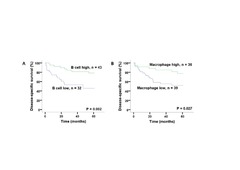Blar i forfatter "Wirsing, Anna Maria"
-
Characterisation and prognostic value of tertiary lymphoid structures in oral squamous cell carcinoma
Wirsing, Anna Maria; Rikardsen, Oddveig G; Steigen, Sonja Eriksson; Uhlin-Hansen, Lars; Hadler-Olsen, Elin Synnøve (Journal article; Tidsskriftartikkel; Peer reviewed, 2014-08-23)<p><i>Background -</i>Oral squamous cell carcinomas are often heavily infiltrated by immune cells. The organization of B-cells, follicular dendritic cells, T-cells and high-endothelial venules into structures termed tertiary lymphoid structures have been detected in various types of cancer, where their presence is found to predict favourable outcome. The purpose of the present study was to evaluate ... -
Evaluation Challenges in the validation of B7-H3 as oral tongue cancer prognosticator
Sieviläinen, Meri; Wirsing, Anna Maria; Hyytiäinen, Aini; Almahmoudi, Rabeia; Rodrigues, Priscila; Bjerkli, Inger-Heidi; Åström, Pirjo; Toppila‑Salmi, Sanna; Paavonen, Timo; Coletta, Ricardo D.; Hadler‑Olsen, Elin; Salo, Tuula; Al‑Samadi, Ahmed (Journal article; Tidsskriftartikkel; Peer reviewed, 2020-09-21)B7-H3 was the only molecule identified with prognostic potential from a recent systematic review of the prognostic value of immune checkpoints in oral cancer. We aimed to validate this finding in a multicenter international cohort. We retrospectively retrieved 323 oral tongue squamous cell carcinoma (OTSCC) samples from three different countries (Brazil, Finland, and Norway) for immunostaining and ... -
The immune microenvironment in oral squamous cell carcinoma – characterization and prognostic markers
Wirsing, Anna Maria (Doctoral thesis; Doktorgradsavhandling, 2018-09-27)Oral squamous cell carcinomas (OSSCs) are aggressive tumors often associated with a low survival rate. The immune system influences the development of OSCCs, and the immune infiltrate surrounding the cancer cells is an indicator of the host’s anti-tumor response. The main aim of this thesis was to describe how the tumor microenvironment in OSCC is organized, and to determine whether different subsets ... -
Presence of high-endothelial venules correlates with a favorable immune microenvironment in oral squamous cell carcinoma
Wirsing, Anna Maria; Ervik, Ida Korsnes; Seppola, Marit; Uhlin-Hansen, Lars; Steigen, Sonja Eriksson; Hadler-Olsen, Elin Synnøve (Journal article; Tidsskriftartikkel; Peer reviewed, 2018-02-07)Oral squamous cell carcinomas are associated with a poor prognosis, which may be partly due to functional impairment of the immune response. Lymphocyte recruitment to the tumor site is facilitated by high-endothelial venules, whereas expression of programmed-death ligand 1 (PD-L1) can impair T-cell function. Thus, we hypothesize that these factors are important in shaping the immune response in oral ... -
Presence of high-endothelial venules correlates with a favorable immune microenvironment in oral squamous cell carsinoma
Wirsing, Anna Maria; Ervik, Ida Korsnes; Seppola, Marit; Uhlin-Hansen, Lars; Steigen, Sonja Eriksson; Hadler-Olsen, Elin (Master thesis; Mastergradsoppgave, 2017-10-31)Oral squamous cell carcinomas (OSCC) are associated with a poor prognosis, which may be partly due to functional impairment of the immune response. Lymphocyte recruitment to the tumor site is facilitated by high-endothelial venules (HEV), whereas expression of programmed-death ligand 1 (PD-L1) can impair T cell function. Thus, we hypothesize that these factors are important in shaping the immune ... -
Presence of tumour high-endothelial venules is an independent positive prognostic factor and stratifies patients with advanced-stage oral squamous cell carcinoma
Wirsing, Anna Maria; Rikardsen, Oddveig G; Steigen, Sonja Eriksson; Uhlin-Hansen, Lars; Hadler-Olsen, Elin Synnøve (Journal article; Tidsskriftartikkel; Peer reviewed, 2015-09-17)Background: Staging of oral squamous cell carcinoma is based on the TNM system, which has been deemed insufficient for prognostic purposes. Hence, better prognostic tools are needed to reflect the biological diversity of these cancers. Previously, high numbers of specialized blood vessels called high-endothelial venules have been reported to be associated with prolonged survival in patients with ... -
Spillbasert læring: motivasjon for å ta i bruk ny teknologi
Solstrand, Tuva; Wirsing, Anna Maria; Beerepoot, Maarten T. P.; Coucheron, David A. (Conference object; Konferansebidrag, 2023-03)Spillbasert læring bruker prinsipper fra spill for å engasjere og motivere studenter i sin læring. I kombinasjon med innsikter om effektive læringsstrategier kan spillbaserte læringsressurser sikre både motivasjon til å lære og en effektiv læringsprosess. En forutsetning for å lykkes med introduksjon av ny teknologi generelt og spillbaserte læringsressurser spesifikt er at teknologien aksepteres av ... -
Tissue-infiltrating immune cells as prognostic markers in oral squamous cell carcinoma: a systematic review and meta-analysis
Hadler-Olsen, Elin Synnøve; Wirsing, Anna Maria (Journal article; Tidsskriftartikkel; Peer reviewed, 2019-02-27)<i>Background</i> - Various immune cells have been suggested as prognostic markers for cancer patients. In this article, we present a systematic review and meta-analysis of studies assessing the prognostic value of tissue-infiltrating immune cells in oral cancer and discuss the reporting quality of these studies.<p> <p><i>Methods</i> - We performed a systematic literature search and included ... -
Validation of Selected Head and Neck Cancer Prognostic Markers from the Pathology Atlas in an Oral Tongue Cancer Cohort
Wirsing, Anna Maria; Bjerkli, Inger-Heidi; Steigen, Sonja Eriksson; Rikardsen, Oddveig G; Norvoll Magnussen, Synnøve; Hegge, Beate; Seppola, Marit; Uhlin-Hansen, Lars; Hadler-Olsen, Elin Synnøve (Journal article; Tidsskriftartikkel; Peer reviewed, 2021-05-14)The Pathology Atlas is an open-access database that reports the prognostic value of protein-coding transcripts in 17 cancers, including head and neck cancer. However, cancers of the various head and neck anatomical sites are specific biological entities. Thus, the aim of the present study was to validate promising prognostic markers for head and neck cancer reported in the Pathology Atlas in oral ...


 English
English norsk
norsk







